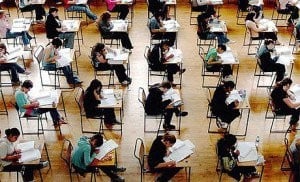Law Schools Have To Actually Teach Lawyers For A Change Or Lose Accreditation
Finally, some teeth to accreditation.
 While the student debt bubble is by no means limited to legal education, law schools have long operated as one of its most pernicious contributors. Once students drift from the relative sure-bets of the elite schools, some scary trends start to emerge. Schools that fail to place graduates in the, you know, legal profession are rampant and a good deal of that failure rests with schools that can’t even produce graduates capable of passing the bar exam. There’s no better way to land a student in a cycle of perpetual debt than to charge a premium for a professional degree and then leave the graduate unable to pursue the profession.
While the student debt bubble is by no means limited to legal education, law schools have long operated as one of its most pernicious contributors. Once students drift from the relative sure-bets of the elite schools, some scary trends start to emerge. Schools that fail to place graduates in the, you know, legal profession are rampant and a good deal of that failure rests with schools that can’t even produce graduates capable of passing the bar exam. There’s no better way to land a student in a cycle of perpetual debt than to charge a premium for a professional degree and then leave the graduate unable to pursue the profession.
Even clown colleges reliably produce clowns.
For the last few years, the powers-that-be have kicked around a proposal to hold accredited law schools to a higher bar passage standard. The ABA’s House of Delegates has rejected the measure to reform the rule a couple of times, but the council of the ABA’s Section of Legal Education and Admissions to the Bar has decided that things have gotten too far out of hand and pushed forward with the new rule:

Legal AI: 3 Steps Law Firms Should Take Now
To be in compliance with the revised version of Standard 316, at least 75% of a law school’s graduates who sat for a bar exam must pass within two years of graduation. Under the previous rule, there were various ways to meet the standard, and no law school had been found to be out of compliance with it.
The old rule, which required a 75 percent bar passage rate or just “not being more than 15 percent worse than the other law schools in the state no matter how terrible they are” has been a paper tiger in practice. This is a testament to the persistence of the Section of Legal Education, which tripled down on the measure following two rejections from the House of Delegates. Under the rules, they only have two shots to kill a proposal from the council. This is a product of the ABA’s “No, Seriously, Shut Up” structure for dealing with its principal deliberative body.
Some critics worry that the rule will wreak havoc on California schools, where the state maintains a nakedly protectionist very difficult exam that routinely finds 70 percent of test-takers failing. But that, ultimately, is California’s problem to fix and not a reason to leave shoddy schools across the country unchecked as they heave unescapable debt upon students with no hope of securing a law license. In legal education, as in life, the argument “well how California does it…” is not particularly compelling.
A more pressing concern about the new rule is the impact it may have on the diversity of the legal profession given that minority students tend to be overrepresented at underperforming schools. But the goal is improving the diversity of the profession not of law schools. If diversity efforts boil down to bankrupting more students of color then everyone loses. Make schools with better track records at turning out lawyers be more diverse rather than rely on pipe dream factories to make the profession look like it’s trying.
Sponsored

Early Adopters Of Legal AI Gaining Competitive Edge In Marketplace

The Business Case For AI At Your Law Firm


Navigating Financial Success by Avoiding Common Pitfalls and Maximizing Firm Performance

Early Adopters Of Legal AI Gaining Competitive Edge In Marketplace
Spring 2020 will see the first wave of schools impacted by the new rule. If out of compliance, they will have two years to get back in line. Something tells me there will be a lot of scrambling schools by this time next year.
ABA legal ed section’s council adopts tighter bar pass standard; clock for compliance starts now [ABA Journal]
Law School Accreditor Raises Bar-Passage Standard [Inside Higher Ed]
 Joe Patrice is a senior editor at Above the Law and co-host of Thinking Like A Lawyer. Feel free to email any tips, questions, or comments. Follow him on Twitter if you’re interested in law, politics, and a healthy dose of college sports news. Joe also serves as a Managing Director at RPN Executive Search.
Joe Patrice is a senior editor at Above the Law and co-host of Thinking Like A Lawyer. Feel free to email any tips, questions, or comments. Follow him on Twitter if you’re interested in law, politics, and a healthy dose of college sports news. Joe also serves as a Managing Director at RPN Executive Search.
Sponsored

Is The Future Of Law Distributed? Lessons From The Tech Adoption Curve








